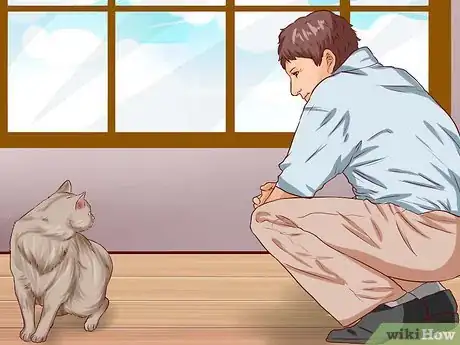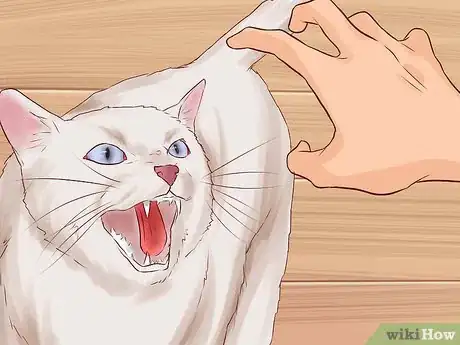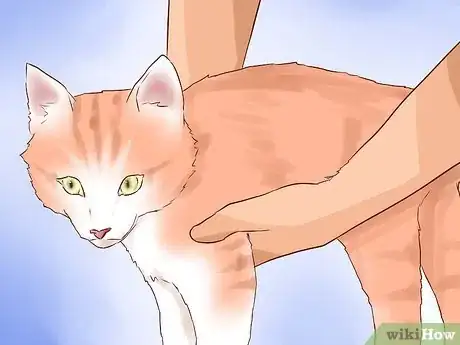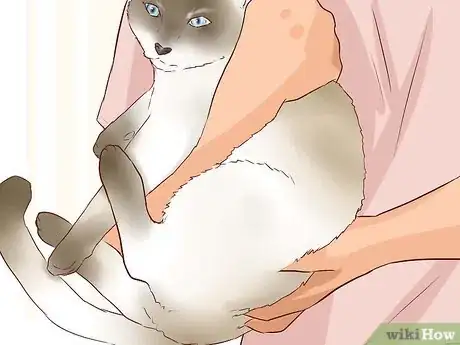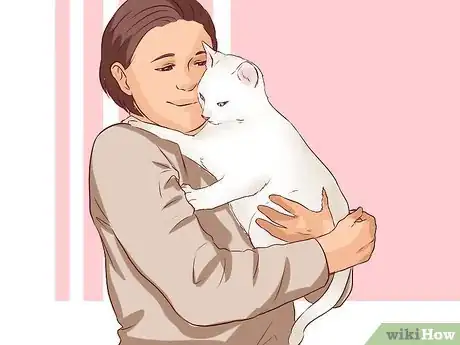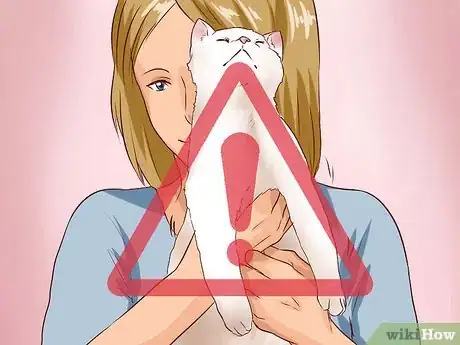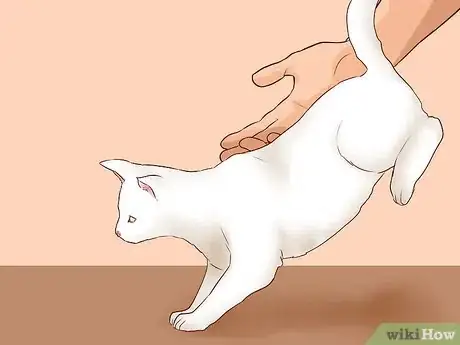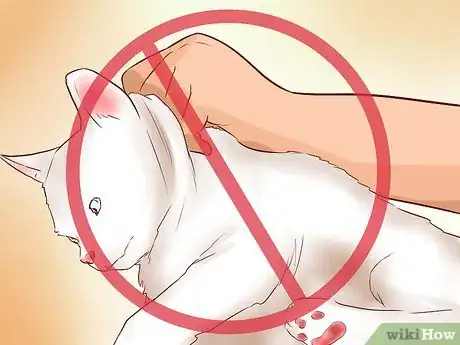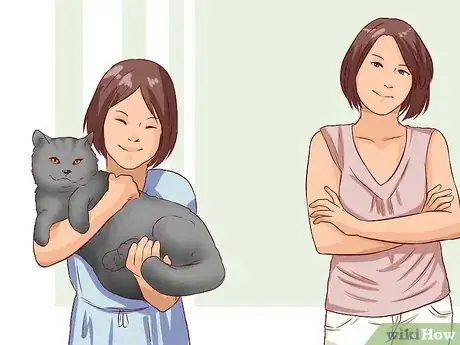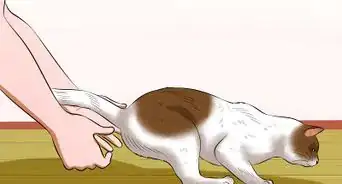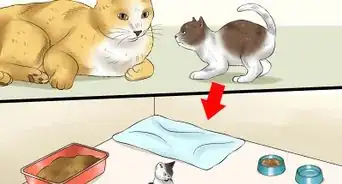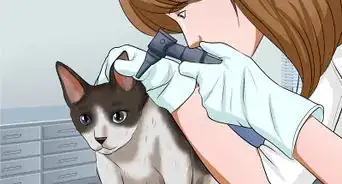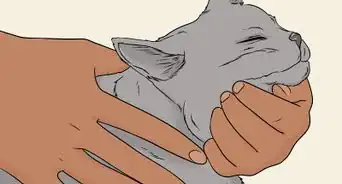This article was co-authored by Brian Bourquin, DVM. Brian Bourquin, better known as “Dr. B” to his clients, is a Veterinarian and the Owner of Boston Veterinary Clinic, a pet health care and veterinary clinic with three locations, South End/Bay Village, the Seaport, and Brookline, Massachusetts. Boston Veterinary Clinic specializes in primary veterinary care, including wellness and preventative care, sick and emergency care, soft-tissue surgery, dentistry. The clinic also provides specialty services in behavior, nutrition, and alternative pain management therapies using acupuncture, and therapeutic laser treatments. Boston Veterinary Clinic is an AAHA (American Animal Hospital Association) accredited hospital and Boston’s first Fear Free Certified Clinic. Brian has over 19 years of veterinary experience and earned his Doctor of Veterinary Medicine from Cornell University.
wikiHow marks an article as reader-approved once it receives enough positive feedback. This article received 13 testimonials and 88% of readers who voted found it helpful, earning it our reader-approved status.
This article has been viewed 547,579 times.
Picking up a cat may sound easy but there is actually a right way to do it, so that the cat is comfortable and does not get injured. Make sure the cat feels safe and comfortable in your presence before you attempt to pick it up. Some cats need a more “delicate” approach than others, especially cats that are frightened of humans or ones with medical conditions like arthritis. Once you have established a relationship with the cat, then it's time to pick it up while supporting its body correctly.
Steps
Putting a Cat at Ease
-
1Approach the cat. If you want to pick up a cat, then you should first approach it in a way that lets it know you're coming. This can mean talking to it softly, letting it see you, or just making your presence known in some way.
- If you pick up your cat from behind without letting it know you're coming, it's likely to get scared and to feel panicked and unsafe.
- Some experts say it's best to approach your cat from the left or right side because coming at your cat head-on may seem like too much of a threat.[1]
- Never attempt to pick up cats you find on the street without carefully assessing the cat and its behavior. It can be feral and potentially dangerous. It is best to only try to pick a cat up if you have experience with it.
-
2Introduce yourself to the cat. It can take time for cats to warm up to you, even cats that you own. Once the cat knows you're approaching, you should be friendly and loving with the cat so it gets ready to be held by you. Most cats introduce themselves to other cats by nuzzling their faces, so you should do the same, focusing on gently petting the cat's cheeks, forehead, the area behind their ears, or even under their chins, if it is comfortable with you.
- This gentle petting can help your cat feel safe and loved and ready to be picked up.
- If your cat is feeling a little bit wound up, this can also help calm him or her down. It may take a bit of time to make your cat feel at ease.
Advertisement -
3Make sure the cat wants to be picked up. Most cats will be able to give you a definite sign that they don't want to be picked up.[2] Though you can slowly calm down and earn the trust of domestic cats by petting their heads, you shouldn't try to pick up a cat who is either irritated or just not in the mood to be picked up. If the cat tries to run away from you or bites or scratches you, or just starts swatting at you, then it may be time to try to pick up the cat later.[3]
- It is especially important to teach children who want to pick up a cat these warning signs. You want them to only pick up a cat who is feeling calm and relaxed and who trusts them. You don't want a child to end up getting scratched by a cat who doesn't want to be held.
Holding a Cat Correctly
-
1Place one hand under the cat's body, behind its front legs, if you are sure that the cat is accepting of being picked up. Gently move your hand under the cat's body, just below its front legs, so you have the support you need when you begin to pick up the cat. The cat may resist this or not like it right away, so you should move along and use that second hand soon afterwards.[4]
- It doesn't really matter whether you use your dominant hand to support the cat below its front legs or under its hindquarters; it depends on whatever makes you feel more comfortable.
- Some people actually tuck the front legs together and place the hand under the two legs instead of below them.
-
2Place the other hand under the cat's hindquarters. Now place that second hand under the cat's back legs, giving plenty of support to its legs and bottom.[5] You can almost think of this as cradling the cat with one of your hands. Once you've gotten your hands in position, you can get ready to pick the cat up.[6]
-
3Gently lift the cat. Now that you're holding the cat with both hands, just gently lift the cat up, towards your chest. Try to make contact with the rest of your body as early as you can when you lift it up. This can help the cat feel more secure early in the process. If the cat is too heavy to lift up from the ground, you may be better off picking it up from a table or an elevated platform.[7]
-
4Hold the cat against your chest. Once you've picked up the cat while supporting it with both hands, you can hold it against your chest, so most of its body is touching your body.[8] The back or side of the cat's head can rest against your chest, too.
- In general, the cat's posture should be fairly straight instead of having the cat sag against your chest, with its head and neck craned downward. This is uncomfortable for the cat and may cause it to struggle and scratch you.
- You should always pick up a cat with its head above its body. Never pick up a cat upside down!
- Of course, some cats like to be held differently, especially if it's your cat and it's more comfortable around you. Some are perfectly fine being cradled like babies while others even like placing their hind legs on your shoulders.
Putting a Cat Down Safely
-
1Know when the cat no longer wants to be held. Once the cat starts shifting around, moving, or even meowing or trying to escape your grasp, it's time to set the cat down. You don't want to hold the cat against its will, as this will make the cat increasingly uncomfortable and it will also feel threatened.
- Some cats don't like to be held for all that long, so if you sense that the cat may be less than pleased in your arms, it's time to let it go.
-
2Gently place the cat down. Don't just throw down the cat the second you feel the little guy is uncomfortable; this may lead the cat to lose its balance or to land awkwardly. Instead, lower the cat down until all four of its paws are on the ground before you comfortably release it.
- Of course, some cats will just jump right out of your grasp, so you can be prepared for that, too.
-
3Do not scruff the cat.[9] Though mother cats carry their kittens by the scruff, you should not try to scruff a cat, especially after it is three months old or so. At that point, the cat will grow too big, and scruffing it can really hurt the cat and cause muscle damage, as the cat will be too big to be adequately supported by the scruff. [10]
- Though you or a vet may need to scruff the cat to get it to take medication or trim its nails they never hold the cat off the examination table by the scruff.
-
4Make sure a child has close supervision while picking up a cat. Kids love to pick up cats, but if they want to do this, you should instruct them through every step of the process. Most importantly, make sure the child is big enough to comfortably pick the cat up. If the child is too small, then he or she may be better off holding the cat while sitting.
- Once the child picks up the cat, make sure to keep an eye on them so you can tell the child when the cat wants to be let go. This will help to keep both the child and the cat from being injured.
Expert Q&A
Did you know you can get expert answers for this article?
Unlock expert answers by supporting wikiHow
-
QuestionHow do you tell your cat you love them?
 Melissa Nelson, DVM, PhDDr. Nelson is a Veterinarian who specializes in Companion and Large Animal Medicine in Minnesota, where she has over 18 years of experience as a veterinarian in a rural clinic. She received her Doctor of Veterinary Medicine from the University of Minnesota in 1998.
Melissa Nelson, DVM, PhDDr. Nelson is a Veterinarian who specializes in Companion and Large Animal Medicine in Minnesota, where she has over 18 years of experience as a veterinarian in a rural clinic. She received her Doctor of Veterinary Medicine from the University of Minnesota in 1998.
Veterinarian
-
QuestionCan you pick up a pregnant cat?
 Melissa Nelson, DVM, PhDDr. Nelson is a Veterinarian who specializes in Companion and Large Animal Medicine in Minnesota, where she has over 18 years of experience as a veterinarian in a rural clinic. She received her Doctor of Veterinary Medicine from the University of Minnesota in 1998.
Melissa Nelson, DVM, PhDDr. Nelson is a Veterinarian who specializes in Companion and Large Animal Medicine in Minnesota, where she has over 18 years of experience as a veterinarian in a rural clinic. She received her Doctor of Veterinary Medicine from the University of Minnesota in 1998.
Veterinarian
-
QuestionCan I pick my cat up by the scruff?
 Melissa Nelson, DVM, PhDDr. Nelson is a Veterinarian who specializes in Companion and Large Animal Medicine in Minnesota, where she has over 18 years of experience as a veterinarian in a rural clinic. She received her Doctor of Veterinary Medicine from the University of Minnesota in 1998.
Melissa Nelson, DVM, PhDDr. Nelson is a Veterinarian who specializes in Companion and Large Animal Medicine in Minnesota, where she has over 18 years of experience as a veterinarian in a rural clinic. She received her Doctor of Veterinary Medicine from the University of Minnesota in 1998.
Veterinarian
Warnings
- Always remember the dangers of being bitten and scratched.⧼thumbs_response⧽
- If you are scratched, wash it out with soap and water, and use a topical antibiotic. If you receive a cat bite do the same and consult your physician as cat bites can quickly lead to serious infections.⧼thumbs_response⧽
- Do not hold the cat on their back in a baby position unless you know the cat doesn’t mind this position. This makes the cat feel insecure and trapped, and it might panic and end up scratching you. Always hold the cat in an upright position against your body for a more secure hold.⧼thumbs_response⧽
- Don't pick up a cat without getting to know it a bit first, and never pick up a stray or wild cat.⧼thumbs_response⧽
- Picking up a cat by the scruff is highly discouraged. The cat can be seriously injured if not picked up by the scruff correctly, and so can you, for this position gives the cat much space to turn around and bite/scratch you.⧼thumbs_response⧽
References
- ↑ http://www.thedailycat.com/behavior/understanding/hold_cat_correctly/#axzz3IzwrBd3L
- ↑ Brian Bourquin, DVM. Veterinarian. Expert Interview. 20 December 2019.
- ↑ https://www.petfinder.com/cats/bringing-a-cat-home/how-to-read-cats-body-language/
- ↑ https://www.aspca.org/pet-care/cat-care/general-cat-care
- ↑ Brian Bourquin, DVM. Veterinarian. Expert Interview. 20 December 2019.
- ↑ http://www.catster.com/cat-behavior/how-to-handle-a-cat
- ↑ http://www.catster.com/cat-behavior/how-to-handle-a-cat
- ↑ Brian Bourquin, DVM. Veterinarian. Expert Interview. 20 December 2019.
- ↑ Brian Bourquin, DVM. Veterinarian. Expert Interview. 20 December 2019.
About This Article
To pick up a cat, start by kneeling or sitting down next to the cat and petting its cheeks, forehead, or the area behind its ears. Once the cat is relaxed, place 1 hand behind the front legs, and the other hand under its back legs and bottom. Then, gently lift up the cat and hold it against your chest so that most of its body is touching you. Additionally, keep 1 hand or arm wrapped around its bottom area to make the cat feel secure and comfortable. For more advice from our Veterinary reviewer, including how to put down your cat once it no longer wants to be held, keep reading.
